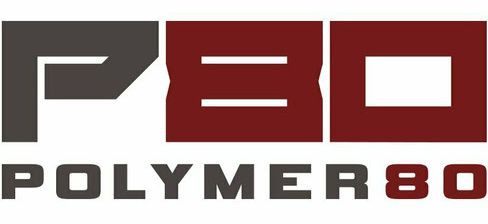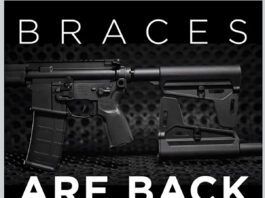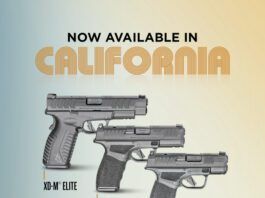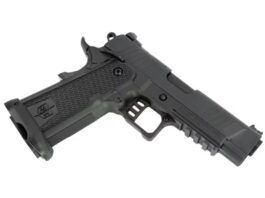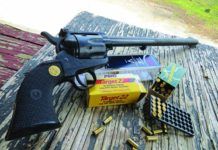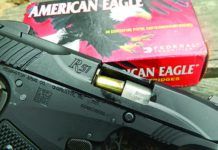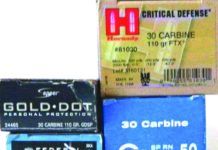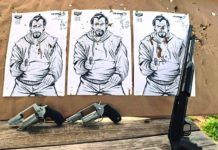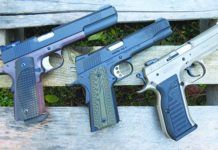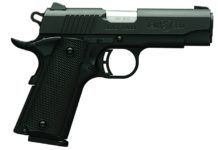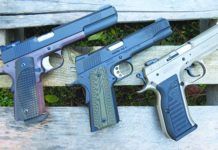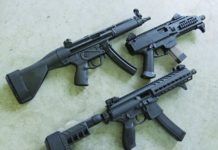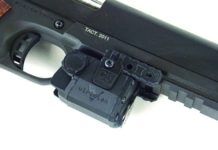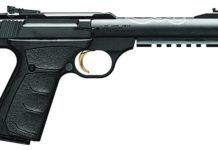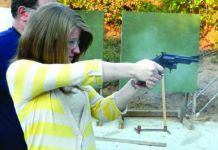A Trio of Unusual Revolvers: Worth the Trouble and Money?
Most gun owners want firearms they can shoot and have fun with, even their life-and-death carry guns. Some of us also want the unusual because we like a walk on the wild side, irrespective of whether it has any use beyond messing around with or plinking. In this Special Report, we take a look at three wheelguns for which there are little or no match ups to find, so head-to-head testing isn't possible. But even without something to shoot beside them, we can learn plenty about whether some unique, or nearly unique, handguns are worth the time and trouble to find and add to your collection as a real, firing item.
Herewith then, we look at the Nagant M1895 7.62x38mmR, the Smith & Wesson Model 929 9mm Luger, and the Chiappa Buntline 22 LR.
Ruger Recalls Most Mark IVs
Ruger has issued a wide recall of all Mark IV and 22/45 models because of a problem with the safety and sear and has told owners that the pistols should not be used.
The issue is: In some cases, if the trigger is pulled while the safety lever is midway between the "safe" and "fire" positions and not full engaged in either, the pistol may or may not fire when the trigger is pulled.
If the gun doesn't fire when the trigger is pulled, it may fire if the user then pushes the safety to the "fire" position without the trigger being activated.
Here's a statement from a Ruger press release on the company's website:
"Although only a small percentage of pistols appear to be affected and we are not aware of any injuries, Ruger is firmly committed to safety and would like to retrofit all potentially affected pistols with an updated safety mechanism. Until your Mark IV pistol has been retrofitted or you verify that it is not subject to the recall, we strongly recommend that you not use your pistol."
Ruger says they have received a "small number" of reports from the field indicating the problem exists. Additional testing confirmed the issue and the recall was issued.
The Return of Remingtons R51 Semi-Auto: How Does It Fare?
We recently tested four single-stack 9mm Luger defense-oriented handguns, among the most popular carry guns in America. Three were single-action pistols and one was a double-action-only model. The spread in expense was pronounced, from less than $200 to more than $700. As always, when we're evaluating carry pistols, handling and accuracy mean a lot, but reliability is the bottom line, and we start with a pistol that has had a mark beside its name for being unreliable. In the lineup was a pistol taking its second bite at the apple, Remington's R51 96430 9mm Luger, which has undergone a recall and revamp and is now back on dealer shelves. Pitted against it were a SIG Sauer P938 Engraved Rosewood Micro-Compact 938-9-ESR, a Taurus 709 Slim 1-709031FS, and a Kel-Tec PF-9.
All of these handguns have a history with us. Most recently, the R51 did well in its initial test in our pages, but was recalled shortly thereafter. In the August 2014 issue, we said, "The Remington R51 was a handy, comfortable pistol of just the right size for its power. Felt recoil with the hottest ammo was amazingly light, and muzzle flip was almost non-existent. It had an odd takedown procedure that was easily mastered. The gun had enough accuracy for its intended purpose. It worked well, was not too expensive, had a great trigger and great sights, and we really liked the concept.
"Though our FFL advised us that other shooters were having function problems with the R51, our test gun simply did not exhibit those problems. Because we only report what happens in our tests and base our grades on our own experiences, we could not fault the R51 for issues other people were having.
"However, after publication of the August print issue, we learned that the R51 had been recalled by Remington. We adjusted the grade on the R51 to an F and returned our test gun to the factory under the recall program."
Then, late last year, Remington Arms Company announced that the R51 had returned to the market with enhancements that included updated slide internals, precision-engineered extractor, locking snag-free sights, tuned recoil spring, hard-chromed barrel bushing, a single-action trigger, and two semi-flush 7+1 round magazines. At the time of the re-release, Remington said the pistol had been extensively tested. The company again touted the R51's features and benefits, including a lightweight aluminum frame with rounded edges for comfortable conceal carry, a grip safety, low bore axis for reduced recoil/muzzle flip, a concealed carry trigger that was a light, crisp single action, low slide racking-force for ease of manipulation, an ambidextrous magazine release, locking drift-adjustable sights, and optimized grip angle. Our test gun, a full replacement of the original, has a suggested retail price of $448.
The last time we looked at the Kel-Tec PF-9 9mm was in April 2011. Of the PF-9, we said, "All business-like flat black, the blued Kel-Tec PF-9 is slim and easily concealable. It was a bit too big for most trouser pockets, but would fit most overcoat pockets. The fixed sights gave an excellent picture that we thought could be improved by widening the rear notch. There were three white dots. The rear sight was adjustable for windage, and by shimming for elevation. An Allen screw secured it. Both the front and rear sights were polymer, as was the trigger and, of course, most of the frame.
"The integral grips had a coarse checkerboard pattern that provided excellent traction, and the front and rear grip straps had vertical serrations. The magazine release was a steel button that was not easy to hit accidentally, but let the mag come out easily when intentionally pressed. The gun could be fired with the magazine removed.
"In our testing we came to love the trigger of the Kel-Tec. We had no trouble whatsoever with short-stroking the trigger in rapid shooting. In fact, the recoil seemed to blow the gun backwards and our trigger finger forward. We were unaware of the trigger needing to be carefully allowed to go all the way forward. We essentially had no problems at all with the Kel-Tec PF-9. We had one failure for the slide to lock back on empty with the first magazine-full through it, but that never happened again. We think this is one mighty fine 9mm handgun, but it is not for the recoil-sensitive person."
About a year later (March 2012) we test-fired the Taurus 709B Slim No. 1-709031. Back then, we said of the handgun, "We never suffered a failure to ignite or any other type of malfunction, so all shots in our tests were performed using the single-action trigger. From the 10-yard bench, only two groups measured 2 inches wide or larger. Overall average size for all groups fired in our tests computed to about 1.5 inches.
30 Carbine Picks: Hornady, Speer, Buffalo Bore Loads Tested
The 30 Carbine cartridge is an interesting and historically significant round. The M1 Carbine was the first little-maintenance firearm issued to the U.S. Army and was also among the first firearms that might correctly be called a Personal Defense Weapon (PDW). Designed for military officers, back-area troops, truck drivers and other personnel not usually armed with a rifle, it was specifically intended to allow officers to carry a lightweight rifle that was more powerful and accurate than a handgun. The carbine was not a short-barrel full-power rifle as earlier carbines had been, being instead designed for a lower-powered cartridge compared to the 30-06 cartridge used in the M1 Garand. Compared to the Russian M44 or the British No. 5 carbine, the M1 carbine is much easier to use well and handle. The M1 Carbine was designed for close-range area defense and personal defense. The concept was successful, and eventually, the army manufactured more than 6 million carbines. Numerous police agencies used the M1 carbine, including post-war Berlin and the NYPD. For close-range battle, the M1 carbine has much to offer.
We feel that the attributes of the M1 Carbine might make it even better suited to home defense than the typical AR-15 rifle. For hunting use and predator control, not so much. We cannot recommend the energy level of the 30 Carbines for deer-sized game, but its low recoil and low muzzle flash are essential for home defense, and the 30 Carbine offers both, but with 357 Magnum energy. The rifle is ergonomic and provides high hit probability. We admit the standard 110-grain FMJ load at about 2000 fps isn't the best choice for home defense, based on over penetration and a lack of wound potential. There have been 110-grain jacketed soft points and jacketed hollowpoints used by police agencies, but most of these loads seem out of production by old mainstays Winchester and Remington. Still, we were able to collect loads using modern expanding bullets and compare them for accuracy penetration and expansion. What we found was that accuracy is good to excellent for all loads, although some were more accurate than others. For use in the home or area defense and animal defense against feral dogs and coyotes to 50 yards or more, the little rifle is plenty accurate. While we find there was something to recommend about all the loads tested, there are standouts. The Buffalo Bore full-power load and the Speer Gold Dot are at the top of the pack for home defense, with the Critical Defense load a strong contender for tactical use.
In this test, we fired 50 cartridges of each load, which included three cartridges each for penetration and expansion testing and fifteen cartridges (three five-shot groups) for accuracy. The remaining 32 rounds were fired in off hand shooting for personal defense work at 5, 7, and 25 yards. We tested accuracy from 25 yards. The rifle was a vintage Israel Arms International carbine. Here are the results.
.410 Bore Self-Defense Choices
The decision of which self-defense .410 firearm is the correct choice for up-close-and-personal situations encountered in the home often comes down to a handgun in one hand or a short-barreled pump-action shotgun in the other. Because of their ease of handling, two revolvers that are capable of firing both .410 loads and handgun rounds are becoming quite popular; and pistol-grip short-barrel shotguns remain a favored option in self-defense circles. The question arises about which type of close-range firearm is the most effective with the diminutive .410 loads, including those that have recently been developed with short-barreled revolvers in mind.
Acting on a reader request, we conducted a multitude of tests on a trio of readily available self-defense firearms that included a Taurus Judge (handles .410-bore shotshells and 45 Colt) that retails for $629; a Smith & Wesson Governor (handles .410, 45 Colt, and 45 ACP) that retails for $809; and a Mossberg Model 500 Cruiser that sells for $467 and fires .410-bore shotshells.
Each of the firearms (all have been examined in previous GT reviews) is specifically designed for close-quarters action, such as when an intruder has illegally entered a residence, placing the people living in the home in a potentially life-threatening situation. In such a life-or-death scenario, a reliable, easy-to-handle, and effective self-defense tool is essential.
In this part of the GT evaluation and match-up, our focus was on the handling ability of the three firearms and their patterning performance at close-quarters ranges. We attempted to walk the fine line that divides ease of handling with putting the pattern in the right place to evaluate the two revolvers and the pump-action.
We tested the firearms on the range with targets set at two ranges used in concealed carry courses to simulate typical home-defense scenarios. The close targets were set at 9 feet (3 yards) and the second set of targets was shot at 21 feet (7 yards). Here are our findings.
10mms: How About the P220?
Neat comparison of 10mms; kinda hoping you'd toss the SIG P220 in 10mm into the mix. I thought your comments on the Kimber TLE II grips were interesting. I haven't shot that model, but I own a Kimber Custom Eclipse II in 10mm and have no such issue with my grips when firing up to 100 rounds in a session. For those who would like the edges less raspy, I use blue buffing on a buffing wheel mounted in my drill press to polish out G10 revolver and knife grips. It's not too aggressive, and you could take a little edge off without substantially changing the grip's appearance. Clean up with a little denatured alcohol and a toothbrush and you're ready for the range.
Browning Adds Five New Pistols to Black Label 1911-380 Line
Browning has added new offerings to the Black Label 1911-380 pistol line.
The new Black Label 1911-380 Medallion Pro will be available in Full Size and Compact versions. These new pistols will feature an aluminum-reinforced composite frame and slide with a blackened stainless steel finish with silver brush-polished flats. Grips on this new model are checkered rosewood with a gold Buckmark logo. The pistol comes with two magazines. The Full Size model barrel length is 4.25 inches and the Compact barrel length is 3.625 inches. Both the Full Size and Compact versions are available with steel three-dot sights or steel night sights. Suggested Retail price with the 3-dot sights: $800. Suggested retail price with night sights: $880.
Browning is also adding three Compact models to the 1911-380 line in 2017. The Black Label 1911-380 Compact has the same features as the Black Label 1911-380 Full Size but with a 3.625-inch barrel. This model has composite black grips and includes fixed combat sights. Suggested retail: $670.
Browning is also adding Compact models to both the Black Label Pro and the Black Label Pro with Rail. Both of these models have 3.625-inch barrels and are available with either steel three-dot sights or steel night sights. The Black Label Pro Compact has a suggested retail price of $800 for the three-dot model and $880 for the night-sight model. The Black Label Pro Compact with Rail and three-dot sight has a suggested retail price of $830, and the railed night sight model has a suggested retail price of $910.
Three More 10mm Autos: Kimber, Dan Wesson, Tanfoglio
Last year we tested three 10mm Auto pistols and found there was a lot of interest in these big-bore handguns, so we decided to return to these powerful handguns for another look. Our most recent crop of 10mms includes two 1911 platforms and one based on the CZ 75 platform. The Kimber Custom TLE II and the Dan Wesson Bruin Bronze share the 1911 platform, while the Tanfoglio Witness is based on the CZ 75 design. We liked all three of these pistols and found that all three could serve multiple duties from hunting to self-defense. Since the 10mm has the power of a 41 Magnum, we feel it is a bit much for everyday carry. If we ever were in a shooting incident, it's possible the overpenetration of the 10mm could be a liability. But in a self-defense situation where you are facing an angry bear in the back country, we think the 10mm Auto makes perfect sense. Also, as a hunting round, the 10mm offers a lot of power and is well suited for game like deer and pigs at short distances. We'd even use it in a tree stand to take black bears visiting a bait.
All three pistols ran exceptionally well with no malfunctions or jams, and we found they were accurate. Two-inch five-shot groups at 25 yards were the norm. For ammunition, we used SIG Sauer V-Crown Ammunition loaded with an 180-grain JHP bullet. The SIG ammo was loaded to velocities that 10mm Auto was designed for.
The other two loads were Federal American Eagle and Armscor USA labels, both using 180-grain FMJs. These two rounds weren't as hot as the SIG load, as the table data reveal. The SIG ammo factory data shows a muzzle velocity of 1250 fps; we got very close to that muzzle velocity from the Kimber and Dan Wesson. The Tanfoglio produced less velocity. The Federal and Armscor ammo is factory-speed stamped at 1030 fps and 1008 fps, respectively. With the three pistols, we saw higher muzzle velocities than the factory figures.
For accuracy testing, we used a rest and open sights, firing at targets placed 25 yards downrange. For our speed stage, we fired at 10 yards. A fast and accurate follow-up shot was faster with the Bruin and Witness, which we will get into shortly. Remember that a 10mm Auto is not a learner's pistol or for those who are sensitive to recoil. In our opinion, the Bruins and the Witness helped us manage recoil the best. Shooting this trio side by side at the range, we learned a lot about them. Here's the skinny on all three.
Big 9mm Pistols Tested? Yes!
The March 2017 issue compared "Forward-Mounted-Mag 9mm Pistols from SIG, Zenith, & CZ." The three super-sized pistols tested included the Zenith Firearms MKE Z-5RS with SB Brace, the CZ Scorpion EVO 3 S1, and the SIG Sauer MPX-PSB. The Zenith and SIG came with braces, while the CZ did not, but one could be purchased separately. All three proved to have good accuracy and reliability as defensive firearms. We preferred the Zenith, though the SIG and CZ performed well. As a subscriber, log on to Gun-Tests.com and read the entire review, either the online version or download the whole issue as a PDF.
Four Affordable 1911 Rail Guns
Guns fitted with accessory rails, aka rail guns, are a popular choice for both self defense and home defense because of their ability to mount a combat light or advanced laser. These are nice features to have on a defense handgun, but they must be paired with features that make a difference to accuracy, reliability, and handling, such as a speed safety and a well-designed beavertail and functional grip safety on their 1911s. Good sights and a crisp trigger response are always important factors as well. But the most important factor is reliability.
New Handguns at SHOT 2017
The New Black Label 1911-22LR Gray full-size and compact models are available with or without a rail. The slides on both are machined aluminum, and the barrel has a gray anodized finish. The frames are composite, with a machined 7075 aluminum subframe and slide rails. Sights are fiber-optic. SRP: $699.99; $719.99 with the rail. A Black Label 1911-22LR Medallion full size and compact will also be offered with similar features for $670.
The Black Label 1911-380 Medallion Pro model, in full-size and compact versions, features a matte-black frame and a blackened stainless-steel slide with silver brush-polished flats. The grips are made of intricately checkered rosewood with a gold Buckmark. Barrel length on the full-size model is 4 inches; on the compact model, it's 3 5⁄8 inches. SRP: $800; $880 with night sights. Black Label 1911-22LR Medallion full-size and compact versions will also be offered with similar features for $670.
357 Magnum Personal Defense Loads: Black Hills Is a Best Buy
When it comes to the 357 Magnum cartridge, the consensus is the round is a great performer. The cartridge has taken deer, bears, and even larger game. However, the rub is that these exploits were made with larger revolvers, often with barrels of at least 6 inches. When it comes to personal defense, most folks are going to carry a 2-, 3-, or 4-inch-barrel revolver. So, for those shooters who prefer the wheelgun, the Magnum needs to work in a shorter barrel.
The slow-burning powder used in Magnum loads is often a canister grade of Winchester 296 or Hodgdon H 110. This powder develops its power and velocity from a slower burn. Purpose-designed defense loads must use relatively faster-burning powder, usually a powder in the middle range. Another problem with accuracy and consistent performance is bullet pull. The lighter bullets used in defense loads often do not show as consistent a powder burn as heavier bullets, and this limits velocity with 100- to 110-grain bullets. However, makers such as Cor-Bon seem to have perfected a loading process that has solved many of the problems with bullet pull and have even gotten a consistent powder burn in short barrels. More pertinent in recent years, the Magnum has been downloaded. In present form, SAAMI specs restrict 357 Magnum pressure levels to about the same as 9mm +P+ loads.
When you consider the flash, blast, and recoil inherent in the Magnum cartridge, the question must be asked: Is the 357 Magnum the best choice for personal defense over other revolver cartridges? We believe it is. The Magnum offers excellent performance in a relatively compact package that the big-bore revolvers cannot match for speed and packing ability. The Magnum is superior to the 38 Special, no matter how hot the Special is loaded. In the May 2012 issue, we looked at the 357 Magnum for animal defense and also have looked at the 9mm versus the 357 Magnum. In this report, we are looking at the 357 Magnum solely as a personal-defense cartridge and letting the Magnum stand on its own.
There are several concerns in choosing the 357 Magnum for personal defense. One of our raters has a great deal of police experience. He noted that the 22 LR, as an example, was a proven, though under-regarded, self-defense round when fired from a rifle largely because of the ease with which accuracy was obtained. From a pistol, the results are often dismal, so the shorter-barrel, lighter revolvers might also produce poor results. Another concern is muzzle blast. The concussion inside a home could be severe, the muzzle blast is tremendous in dim light, and sometimes the flash causes night blindness. The Magnum might literally leave you deaf and dumb. However, some modern loads are especially treated to create only light muzzle flash, and as a result, they are much better suited to personal defense. If you choose a heavy hunting load and fire it in a 4-inch barrel, you will probably experience excess muzzle blast. If you use the 110-grain Cor-Bon personal-defense load, you will not experience this excess muzzle blast. The Buffalo Bore 125-grain Tactical load is another excellent choice, carefully tailored to personal defense.

























